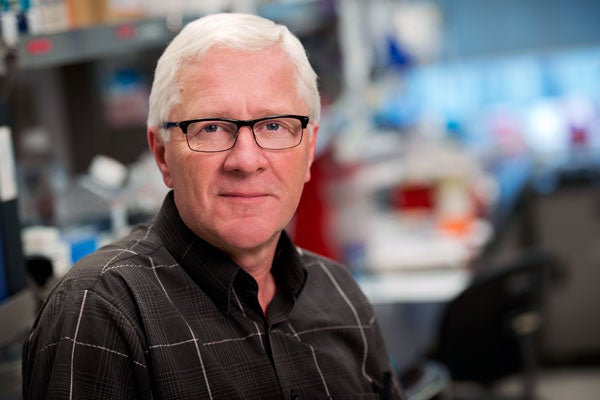
Time to rewrite the textbooks? Research redefines how stem cells make blood
Published: November 5, 2015
Stem-cell scientists led by the University of Toronto's Dr. John Dick have discovered a completely new view of how human blood is made, upending conventional dogma from the1960s.
The findings, published online Nov. 5 in the journal Science, prove “that the whole classic ‘textbook’ view we thought we knew doesn’t actually even exist,” says Professor Dick, the principal investigator.
Dick is senior scientist at Princess Margaret Cancer Centre, University Health Network (UHN), and a professor in the department of molecular genetics at U of T.
“Instead, through a series of experiments we have been able to finally resolve how different kinds of blood cells form quickly from the stem cell – the most potent blood cell in the system – and not further downstream as has been traditionally thought,” says Dick, who holds a Canada Research Chair in Stem Cell Biology and is also director of the Cancer Stem Cell Program at the Ontario Institute for Cancer Research.
Below, Dick talks about the research
The research also topples the textbook view that the blood development system is stable once formed. Not so, says Dr. Dick. “Our findings show that the blood system is two-tiered and changes between early human development and adulthood.”
Co-authors Dr. Faiyaz Notta and Dr. Sasan Zandi from the Dick lab write that in redefining the architecture of blood development, the research team mapped the lineage potential of nearly 3,000 single cells from 33 different cell populations of stem and progenitor cells obtained from human blood samples taken at various life stages and ages.
“Our discovery means we will be able to understand far better a wide variety of human blood disorders and diseases”
For people with blood disorders and diseases, the potential clinical utility of the findings is significant, unlocking a distinct route to personalizing therapy.
Dick says: “Our discovery means we will be able to understand far better a wide variety of human blood disorders and diseases – from anemia, where there are not enough blood cells, to leukemia, where there are too many blood cells. Think of it as moving from the old world of black-and-white television into the new world of high definition.”
There are also promising implications for advancing the global quest in regenerative medicine to manufacture mature cell types such as platelets or red blood cells by engineering cells (a process known as inducing pluripotent stem cells), says Dick, who collaborates closely with Professor Gordon Keller of the department of medical biophysics at U of T and a director of UHN’s McEwen Centre for Regenerative Medicine.
“By combining the Keller team’s ability to optimize induced pluripotent stem cells with our newly identified progenitors that give rise only to platelets and red blood cells, we will be able develop better methods to generate these mature cells,” he says. Currently, human donors are the sole source of platelets – which cannot be stored or frozen – for transfusions needed by many thousands of patients with cancer and other debilitating disorders.
Today’s discovery builds on Dick’s breakthrough research in 2011, also published in Science, when the team isolated a human blood stem cell in its purest form – as a single stem cell capable of regenerating the entire blood system.
“Four years ago, when we isolated the pure stem cell, we realized we had also uncovered populations of stem-cell like ‘daughter’ cells that we thought at the time were other types of stem cells,” says Dick. “When we burrowed further to study these ‘daughters’, we discovered they were actually already mature blood lineages. In other words, lineages that had broken off almost immediately from the stem cell compartment and had not developed downstream through the slow, gradual ‘textbook’ process.
“So in human blood formation, everything begins with the stem cell, which is the executive decision-maker quickly driving the process that replenishes blood at a daily rate that exceeds 300 billion cells.”
For 25 years, Dick’s research has focused on understanding the cellular processes that underlie how normal blood stem cells work to regenerate human blood after transplantation and how blood development goes wrong when leukemia arises. His research follows on the original 1961 discovery of the blood stem cell by Princess Margaret Cancer Centre scientists Dr. James Till and the late Dr. Ernest McCulloch, which formed the basis of all current stem-cell research.
The research published today was funded by the Canadian Institutes for Health Research, Canadian Cancer Society, Terry Fox Foundation, Genome Canada through the Ontario Genomics Institute, Ontario Institute of Cancer Research, a Canada Research Chair, the Ontario Ministry of Health and Long-term Care, and The Princess Margaret Cancer Foundation.



